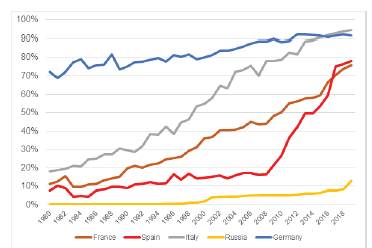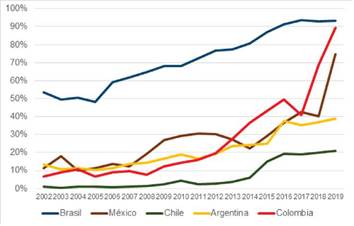In the first half of the twentieth century, the main developments of science were communicated in at least half a dozen languages. Charcot, Déjerine and Gilíes de la Tourette had published their pioneering contributions in French; Jackson, Willis and Sydenham in English; Purkinje, Alzheimer and Virchow in German; Golgi in Italian; Ramón y Cajal in Spanish; and Bekhterev, Pavlov and Luria in Russian. The first edition of the Index Medicus, from 1879, included 20,169 articles, 4781 from American publications, 4608 French, 4027 German, 3592 English, 1210 Italian, 703 Spanish, and 1248 from other countries and languages 1. After World War II, in great part due to the influence of American medicine, the proportion of English language publications started to grow steadily. The Germans were the first to sacrifice their mother tongue. Figure 1 shows how German medical journals (at least those indexed in Medline) were ahead of the other main European countries in starting to move towards English, presumably in order to increase the visibility of their research. Russia has been the most reticent. Interesting to see how Spain-based journals, which published less than one fifth of their articles in English, have changed their policy dramatically in the last decade.

Figure 1 Proportion of English-language publications in Medline-indexed journals from five non-English speaking European countries.
The picture in Latin America is also interesting (Figure 2). Brazil has been publishing more articles in English than in Portuguese during the last twenty years or so, and the proportion has been of 90 percent or more in the last few years. Mexico, Argentina and Colombia have been lagging behind, but the number of publications in English shows a clear growing trend, with Chile, surprisingly, showing the lowest figure of this group. The case of Peru, not showed in the graph, is also slowly changing, with only 53 of 901 (5.9%) references included since 2015 in English.

Figure 2 Proportion of English-language publications in Medline-indexed journals from five Latin American countries.
The main, and obvious, advantage of writing in English is the chance of reaching a much larger audience not only English-speaking countries but, literally, in every corner of the world where Science is being produced. There is abundant evidence to support the fact that chances of being cited are higher if a paper is published in English. Bitetti and Ferreras, in Argentina, analyzed citations of 1328 articles published in six science journals from five countries (Argentina, France, Japan, Mexico and South Korea). They found that 34% of the 728 articles published in English had not been cited, compared with 46% of the 600 published in other languages 2. A similar study with dental journals in Switzerland showed six and seven times higher odds of being cited for articles published in English, compared with those in German or French 3.
At a local level, the first Colombian Medline-indexed article published both in English and Spanish in the journal Biomedica can serve as a good example. Exactly the same article on yellow fever in its Spanish version 4 has been cited just 5 times, while the English version 5 has received 43 citations (Scholar Google, February 25, 2020).
For journals in highly monolingual countries like Colombia, moving towards publishing in English has several problems. First, it sets yet another barrier for local clinicians, most of which find it difficult to write their experience even in their native language. Second, many of our readers, most of them clinicians or medical students, are not fluent in English. More articles could go unread. It could be argued that some documents, like consensus statements of clinical practice guidelines, have a strictly local interest, and its impact could be hindered if translated into English.
In other ields, different to science, multiligualism might be the norm. Literature, for example. Meneghini and Packer, writing in 2007, pointed out how only nine of the previous 25 Nobel Prize winners wrote their masterpieces in English 6. Swedish judges had to wait for a translation. For Physics, Chemistry, and Physiology or Medicine, the Nobel Prize committees at the Royal Swedish Academy of Sciences do not have to wait for translators to do their job since almost all laureates are either native English speakers or have been publishing their findings in English language journals, anyway.
Our proposal, starting 2020, is that this journal will be completely bilingual. Every editorial, case report, review, or full article can be submitted in either language, and will be published in both. We will be following the example of other medical journals, like the Revista Española de Cardiología that started posing these same questions 15 years back 7, or the 6 Colombian journals currently indexed in Pubmed. We believe English is the way to go. Wish us luck!.














